A Computational Analysis of Turbocharger Compressor Flow Field with a Focus on Impeller Stall
Abstract
1. Introduction
2. Computational Domain
2.1. Model Description
2.2. Model Assumptions
- Working fluid (air) has constant material properties and obeys the ideal gas law.
- The fluid zones have adiabatic walls.
- All duct, impeller, shroud, diffuser, and volute walls are smooth.
- The ‘all-’ wall treatment with a wall mesh of around 30 is utilized.
- Turbocharger shaft vibrations and speed fluctuations are neglected.
- URANS (k-ω SST) turbulence model with a linear constitutive relation between Reynolds stress and strain rate is used.
3. Results and Discussion
3.1. Operating Points and Model Validation
3.1.1. CFD Operating Points
3.1.2. Performance and Efficiency Comparison
3.1.3. Velocity Field Comparisons between Predictions and Experiments
3.2. Flow Field Analysis
3.2.1. Analysis of Stationary Stall Cells
3.2.2. Analysis of Rotating Stalls
4. Conclusions
- Three-dimensional CFD predictions were carried out to study the turbocharger compressor flow field at three discrete mass flow rates of 77, 57, and 30 g/s at a fixed rotational speed of 80,000 rpm. The three operating points are chosen such that 77 g/s is the maximum mass flow rate at 80 krpm without any flow reversal; 57 g/s is the operating point near peak efficiency where the reverse flow from the impeller does not yet reach the inlet duct walls; and the last operating point, 30 g/s, is a flow rate where the inlet recirculation is well established within the inlet duct. The predictions agreed well with measurements from the turbocharger stand, including compressor performance and efficiency. The velocity distributions from the CFD predictions were also validated against PIV measurements obtained earlier.
- The simulations were thereafter used to analyze the compressor flow field with a focus on the stall instability. The study identified the parts of the turbocharger compressor map where stationary and inducer rotating stall phenomena are observed. While stationary stall cells started forming within the impeller near the peak efficiency point at 57 g/s, they became more pronounced with further reduction in flow rate and were not observed at all at the maximum flow condition (77 g/s). On the other hand, the inducer rotating stall was found even at the maximum flow rate of 77 g/s, which became most prominent near the peak efficiency point (at 57 g/s) and disappeared at lower flow rates.
- The present work also identifies the locations within the impeller where the stationary stall cells develop. These stall cells were identified near the shroud exclusively between the suction surface of the main blades and the pressure surface of the splitter blades. Axially, these were located between 8.78 mm and 12.5 mm from the leading edges of the main blades, a region where the axial to radial bend of the shroud starts to become prominent. With a reduction in the compressor mass flow rate from 77 to 57 and then to 30 g/s, the incidence angle at the blade tips increases, and flow separation takes place from the suction surface of the main blades. The strong adverse pressure gradient inside the impeller pushes this separated fluid back toward the inlet, leading to the generation of the reverse flow. A part of the core flow within the impeller cannot follow the axial to radial bend of the shroud against this adverse pressure gradient and becomes entrained back toward the inlet by the reverse flow and the tip leakage flow. This creates a region of low-momentum fluid in the wake of the blockage created by the strong annular reverse flow pattern, giving rise to the stall cells. These cells also correspond to regions of low relative total pressure. The non-uniformities or gradients in the distributions of relative total pressure indicate a possible role of secondary flows in the generation and orientation of the stationary stall cells.
- The stationary stall cells occupy a significant portion of the blade passage at 30 g/s, thereby reducing the effective blade height and the diffusion of the relative flow. They increase the non-uniformities in the flow field, leading to further flow losses. These effects are reflected in the deterioration of compressor efficiency at this operating point.
- The study further revealed the presence of rotating stall cells near the blade tips on the inducer plane at 57 g/s. These manifested as alternating cells of positive and negative dynamic pressure, which rotated in the same direction as that of the compressor wheel at about 45% of the inducer tip speed. These were generated mainly due to the entrainment of the tip leakage flow by the forward-moving core flow, giving rise to a wavy, unstable shear layer at the inducer plane along with several vortical structures near the blade tips. These instabilities were observed to a lesser extent within the impeller at 77 g/s, about 2.5 to 5 mm from the inducer plane, and were almost completely absent at 30 g/s. The prominence of the inducer rotating stall at somewhat higher flow rates is relatively rare, and the present paper illustrates the mechanism that led to its formation and subsequent disappearance at lower flow rates.
- The study also characterized how the entropy generation (associated irreversibilities) within the compressor changes at the three flow rates. The entropy generation was mainly caused by viscous dissipation and increased in strength with a reduction in compressor mass flow rate. At 77 g/s, it was found to mainly occur within the impeller near the shroud, with the core flow appearing to be almost isentropic. On the other hand, at 30 g/s, the entire compressor blade passage showed significant entropy generation, with the peak still being near the shroud. Irreversibilities were also found to occur in the inlet duct at 30 g/s within the annular reverse flow region and in the shear layer between the reverse and forward flows. The interaction of the tip leakage flow with the blades and core flow, along with the production of reverse flow, are major sources of entropy generation within the compressor.
Author Contributions
Funding
Data Availability Statement
Conflicts of Interest
Nomenclature
| b | Exducer b-width |
| D | Diameter |
| f | Frequency |
| h | Local blade height from hub |
| H | Total height from hub to shroud |
| k | Turbulent kinetic energy; thermal conductivity |
| ℓ | Upstream distance from origin along negative X-axis |
| m | Number of rotating stall cells |
| Mass flow rate | |
| N | Rotational speed in rpm |
| p | Pressure |
| Pr | Prandtl number |
| PR | Pressure ratio |
| r, R | Radius |
| RS | Rotating stall |
| Rotor-rotating stall | |
| Mean strain rate tensor | |
| Fluctuating strain rate | |
| Volumetric rate of entropy generation | |
| Temperature | |
| Mean static temperature | |
| Fluctuating static temperature field | |
| Centerline mean axial velocity in the inlet duct | |
| Exducer tip speed | |
| w | Relative velocity |
| X | Axial direction |
| Y | Radial direction |
| Z | Out-of-plane (tangential) direction; number of main blades |
| Greek Symbols | |
| Thermal diffusivity | |
| Dissipation rate | |
| Compressor isentropic efficiency | |
| Dynamic viscosity | |
| Density | |
| Flow coefficient | |
| Angular velocity; vorticity; specific dissipation rate | |
| Subscripts | |
| 0 | Total (stagnation) |
| 1 | Compressor inlet location |
| 2 | Compressor outlet location |
| BPF | Blade passing frequency |
| c | Compressor |
| cor | Corrected quantity |
| h | Hub of impeller |
| ref | Reference quantity |
| s | Shroud of impeller |
| t | Turbulent |
| therm | Thermal |
| tip | Tip of inducer |
| tt | Total-to-total |
| visc | Viscous |
| X | Axial direction |
| Y | Radial direction |
| Z | Tangential direction |
| θ | Tangential component |
Appendix A. Analysis of Entropy Generation at the Compressor Inlet
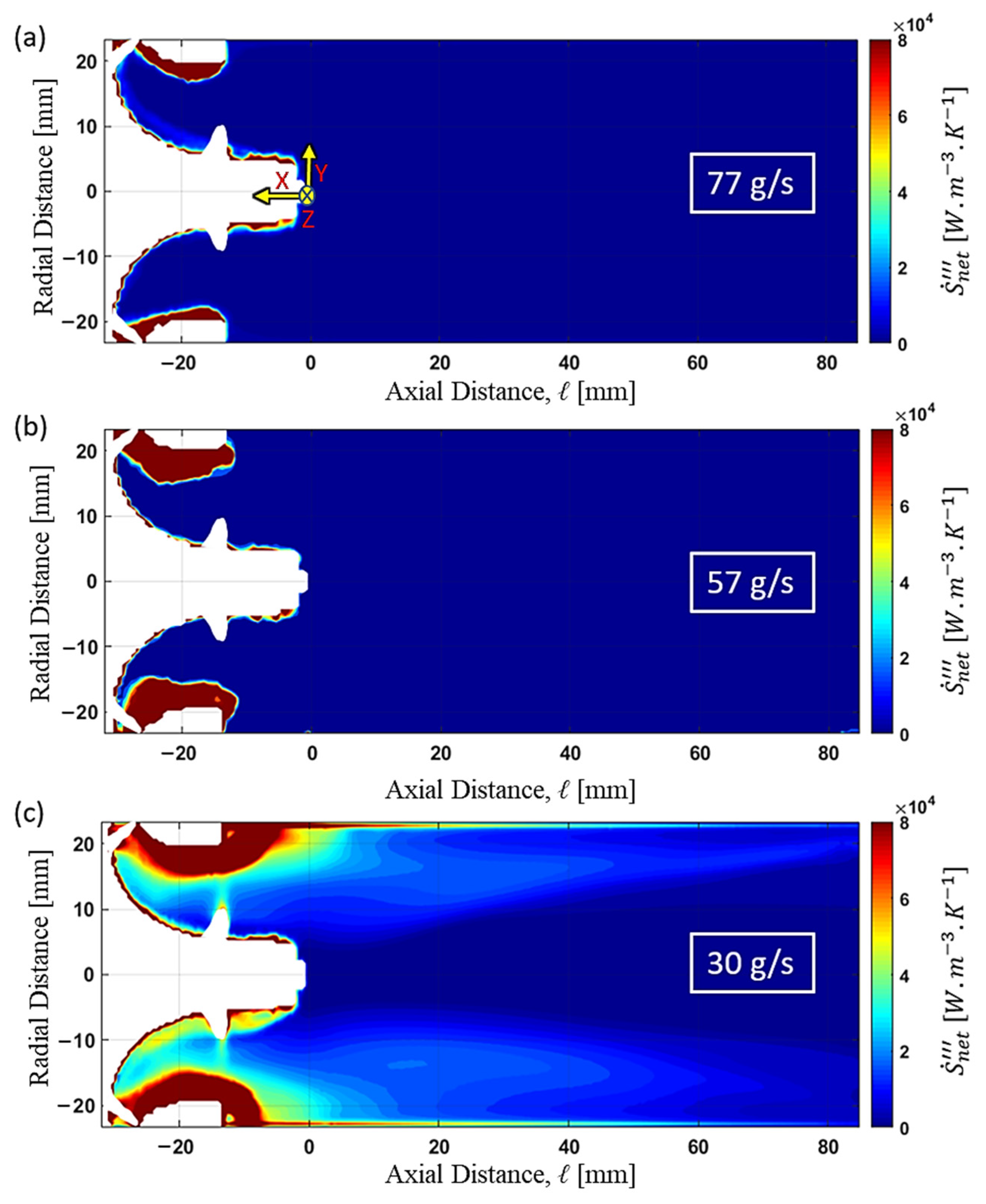
Appendix B. Dynamic Pressure Analyses
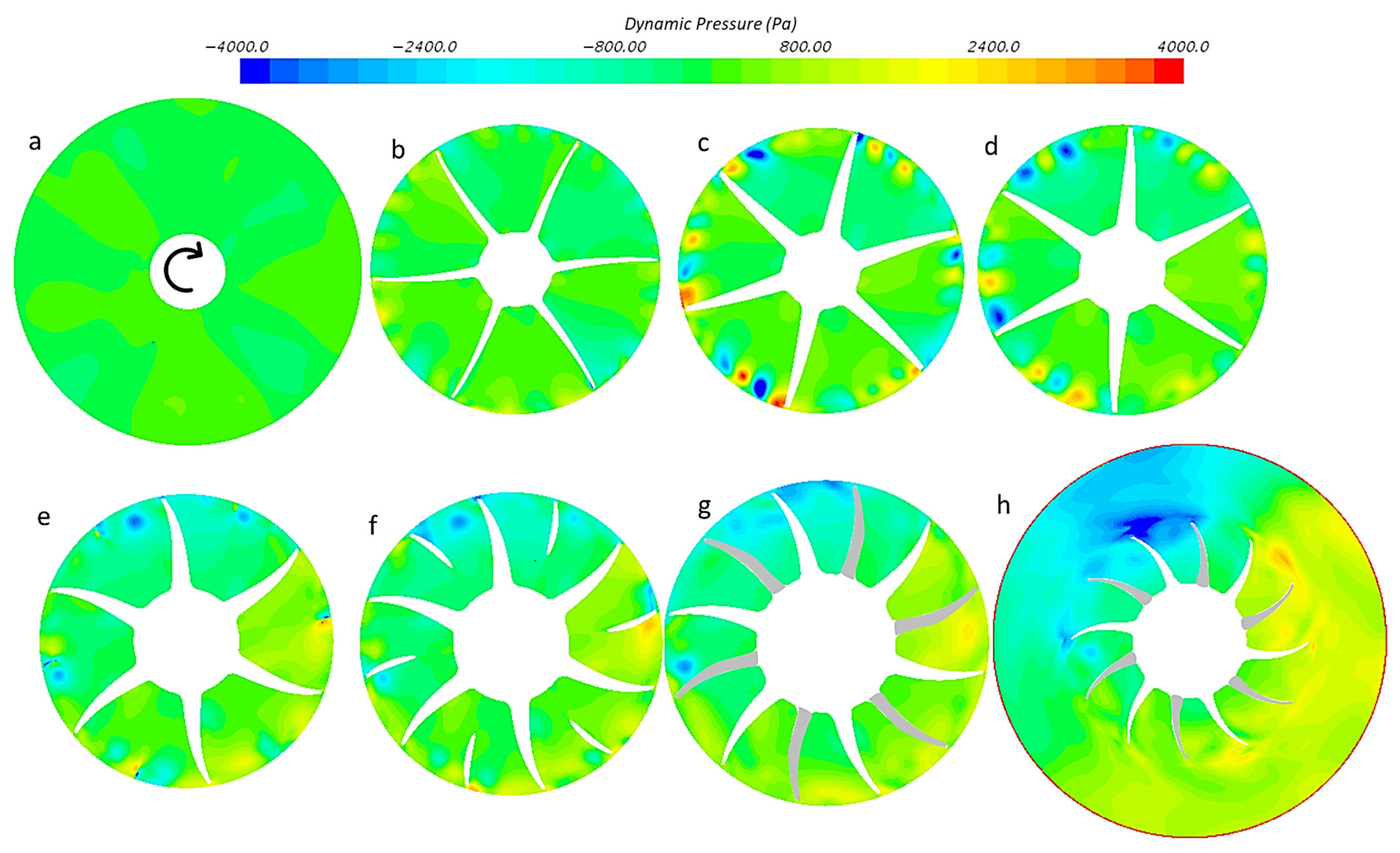

References
- Heywood, J.B. Internal Combustion Engine Fundamentals; McGraw-Hill Inc.: New York, NY, USA, 1988. [Google Scholar]
- Baines, N.C. Fundamentals of Turbocharging; Concepts ETI: White River Junction, VT, USA, 2005. [Google Scholar]
- Dehner, R.; Selamet, A.; Keller, P.; Becker, M. Simulation of Deep Surge in a Turbocharger Compression System. In Proceedings of the ASME Turbo Expo, Copenhagen, Denmark, 11–15 June 2012; ASME Technical Paper GT2012-69124. American Society of Mechanical Engineers (ASME): New York, NY, USA, 2012. [Google Scholar]
- Dehner, R.; Selamet, A.; Keller, P.; Becker, M. Prediction of Surge in a Turbocharger Compression System vs. Measurements. SAE Int. J. Engines 2011, 4, 2181–2192. [Google Scholar] [CrossRef]
- Eckardt, D. Flow field analysis of radial and backswept centrifugal compressor impellers, Part 1: Flow measurement using a laser velocimeter. In Proceedings of the 25th ASME Annual International Gas Turbine Conference and Exhibit and 22nd Annual Fluids Engineering Conference, New Orleans, LA, USA, 9–13 March 1980. [Google Scholar]
- Krain, H. Swirling impeller flow. In Proceedings of the 32nd ASME Gas Turbine Conference and Exhibit, Anaheim, CA, USA, 31 May–4 June 1987; ASME Technical Paper 85-GT-85. American Society of Mechanical Engineers (ASME): New York, NY, USA, 1987. [Google Scholar]
- Cumpsty, N.A. Compressor Aerodynamics; Krieger: Malabar, FL, USA, 1989. [Google Scholar]
- Japikse, D. Centrifugal Compressor Design and Performance; Concepts ETI: White River Junction, VT, USA, 1996. [Google Scholar]
- Day, I.J. Stall, Surge, and 75 Years of Research. ASME J. Turbomach. 2016, 138, 011001. [Google Scholar] [CrossRef]
- Day, I.J.; Cumpsty, N.A. The Measurement and Interpretation of Flow Within Rotating Stall Cells in Axial Com pressors. J. Mech. Eng. Sci. 1978, 20, 101–115. [Google Scholar] [CrossRef]
- Day, I.J. Stall Inception in Axial Flow Compressors. ASME J. Turbomach. 1993, 115, 1–9. [Google Scholar] [CrossRef]
- Vo, H.D.; Tan, C.S.; Greitzer, E.M. Criteria for Spike Initiated Rotating Stall. ASME J. Turbomach. 2008, 130, 011023. [Google Scholar] [CrossRef]
- Camp, T.R.; Day, I.J. A Study of Spike and Modal Stall Phenomena in a Low-Speed Axial Compressor. ASME J. Turbomach. 1998, 120, 393–401. [Google Scholar] [CrossRef]
- Spakovszky, Z.S.; Roduner, C.H. Spike and Modal Stall Inception in an Advanced Turbocharger Centrifugal Compressor. ASME J. Turbomach. 2009, 131, 031012. [Google Scholar] [CrossRef]
- Mailach, R.; Lehmann, I.; Vogeler, K. Rotating Instabilities in an Axial Compressor Originating From the Fluctuating Blade Tip Vortex. ASME J. Turbomach. 2001, 123, 453–460. [Google Scholar] [CrossRef]
- März, J.; Hah, C.; Neise, W. An Experimental and Numerical Investigation into the Mechanisms of Rotating Instability. ASME J. Turbomach. 2002, 124, 367–374. [Google Scholar] [CrossRef]
- Pardowitz, B.; Moreau, A.; Tapken, U.; Enghardt, L. Experimental identification of rotating instability of an axial fan with shrouded rotor. Proc. IInst. Mech. Eng. Part A J Power Energy 2015, 229, 520–528. [Google Scholar] [CrossRef]
- Wu, Y.; Li, T.; Lai, S.; Tian, J.; Ouyang, H. Investigation of rotating instability characteristics in an axial compressor with different tip clearances. Proc. Inst. Mech. Eng. Part G J. Aerosp. Eng. 2021, 235, 2225–2239. [Google Scholar] [CrossRef]
- Grondin, J.; Trébinjac, I.; Rochuon, N. Rotating Instabilities Versus Rotating Stall in a High-Speed Centrifugal Compressor. In Proceedings of the ASME Turbo Expo, Oslo, Norway, 11–15 June 2018; ASME Technical Paper GT2018-76916. American Society of Mechanical Engineers (ASME): New York, NY, USA, 2018. [Google Scholar]
- Iwaraki, K.; Furukawa, M.; Ibaraki, S.; Tomita, I. Unsteady and Three-Dimensional Flow Phenomena in a Transonic Centrifugal Compressor Impeller at Rotating Stall. In Proceedings of the ASME Turbo Expo: Power for Land, Sea, and Air, Orlando, FL, USA, 8–12 June 2009; ASME Technical Paper GT2009-59516. American Society of Mechanical Engineers (ASME): New York, NY, USA, 2009; pp. 1611–1622. [Google Scholar]
- Tomita, I.; Ibaraki, S.; Furukawa, M.; Yamada, K. The Effect of Tip Leakage Vortex for Operating Range Enhancement of Centrifugal Compressor. ASME J. Turbomach. 2013, 138, 051020. [Google Scholar] [CrossRef]
- Cao, T.; Kanzaka, T.; Xu, L.; Brandvik, T. Tip Leakage Flow Instability in a Centrifugal Compressor. In Proceedings of the ASME Turbo Expo, Phoenix, AZ, USA, 17–21 June 2019; ASME Technical Paper GT2019-90217. American Society of Mechanical Engineers (ASME): New York, NY, USA, 2019. [Google Scholar]
- Guleren, K.; Turan, A.; Pinarbasi, A. Large Eddy Simulation of the Flow in a Low-Speed Centrifugal Compressor. Int. J. Numer. Methods Fluids 2008, 56, 1271–1280. [Google Scholar] [CrossRef]
- Miura, T.; Yamashita, H.; Takeuchi, R.; Sakai, N. Numerical and Experimental Study on Rotating Stall in Industrial Compressor. ASME J. Turbomach. 2021, 143, 081008. [Google Scholar] [CrossRef]
- Margot, X.; Gil, A.; Tiseira, A.; Lang, R. Combination of CFD and Experimental Techniques to Investigate the Flow in Centrifugal Compressors Near the Surge Line; SAE Technical Paper 2008-01-0300; SAE International: Warrendale PA, USA, 2008. [Google Scholar] [CrossRef]
- Hellstrom, F.; Gutmark, E.; Fuchs, L. Large Eddy Simulation of the Unsteady Flow in a Radial Compressor Operating Near Surge. ASME J. Turbomach. 2012, 134, 051006. [Google Scholar] [CrossRef]
- Bousquet, Y.; Carbonneau, X.; Dufour, G.; Binder, N.; Trebinjac, I. Analysis of the Unsteady Flow Field in a Centrifugal Compressor from Peak Efficiency to Near Stall with Full-Annulus Simulations. Int. J. Rotating Mach. 2014, 2014, 729629. [Google Scholar] [CrossRef][Green Version]
- Banerjee, D.K.; Dehner, R.; Selamet, A.; Miazgowicz, K.; Tallio, K.; Keller, P.; Shutty, J. Investigation of Flow Field at the Inlet of a Turbocharger Compressor using Digital Particle Image Velocimetry. ASME J. Turbomach. 2019, 141, 121003. [Google Scholar] [CrossRef]
- Banerjee, D.K.; Dehner, R.; Selamet, A.; Miazgowicz, K.; Brewer, T.; Keller, P.; Shutty, J.; Schwarz, A. Investigation of Cross-Sectional Velocity Field Near the Inducer Plane of a Turbocharger Compressor Using 2D Particle Image Velocimetry. In Proceedings of the ASME Turbo Expo, Phoenix, AZ, USA, 17–21 June 2019; ASME Technical Paper GT2019-90384. American Society of Mechanical Engineers (ASME): New York, NY, USA, 2019. [Google Scholar]
- Banerjee, D.K.; Dehner, R.; Selamet, A.; Miazgowicz, K. Impact of Rotational Speed on Turbocharger Compressor Surge through PIV. ASME J. Fluids Eng. 2021, 143, 061501. [Google Scholar] [CrossRef]
- Uhlenhake, G.; Selamet, A.; Fogarty, K.; Tallio, K.; Keller, P. Development of an Experimental Facility to Characterize Performance, Surge, and Acoustics in Turbochargers; SAE Paper No. 2011-01-1644; SAE International: Warrendale, PA, USA, 2011. [Google Scholar] [CrossRef]
- Siemens. STAR-CCM+ (Version 12.06.010); Siemens: Melville, NY, USA, 2018. [Google Scholar]
- Dehner, R.; Selamet, A. Prediction of Broadband Noise in an Automotive Centrifugal Compressor with Three-Dimensional Computational Fluid Dynamics Detached Eddy Simulations. SAE Int. J. Adv. Curr. Pract. Mobil. 2019, 1, 1702–1713. [Google Scholar] [CrossRef]
- Zhang, W.; Lyncg, M.; Reynolds, R. A Practical Simulation Procedure using CFD to Predict Flow Induced Sound of a Turbocharger Compressor. SAE Int. J. Passeng. Cars-Mech. Syst. 2015, 8, 521–525. [Google Scholar] [CrossRef]
- Wilcox, D.C. Turbulence Modeling for CFD; DCW Industries, Inc.: Glendale, AZ, USA, 1993. [Google Scholar]
- Menter, F.R. Two-equation eddy-viscosity turbulence models for engineering applications. AIAA J. 1994, 32, 1598–1605. [Google Scholar] [CrossRef]
- Johnson, M.W. Secondary Flow in Rotating Bends. ASME J. Eng. Power 1978, 100, 553–560. [Google Scholar] [CrossRef]
- Selamet, A. CFD Dynamic Pressure Animations. 2022. Available online: https://vimeo.com/755267896 (accessed on 29 September 2022).
- Kameier, F.; Neise, W. Rotating Blade Flow Instability as a Source of Noise in Axial Turbomachines. J. Sound Vib. 1997, 203, 833–853. [Google Scholar] [CrossRef]
- Raitor, T.; Neise, W. Sound Generation in Centrifugal Compressors. J. Sound Vib. 2008, 314, 738–756. [Google Scholar] [CrossRef]
- Dehner, R.; Selamet, A.; Sriganesh, P.; Banerjee, D.K.; Selamet, E.; Karim, A.; Brewer, T.; Morelli, A. Physical Insight into Whoosh Noise in Turbocharger Compressors using Computational Fluid Dynamics. In Proceedings of the ASME Turbo Expo 2022, Rotterdam, The Netherlands, 13–17 June 2022; ASME Paper No. GT2022-78205. American Society of Mechanical Engineers (ASME): New York, NY, USA, 2022. [Google Scholar]
- Jeong, J.; Hussain, F. On the identification of a vortex. J. Fluid Mech. 1995, 285, 69–94. [Google Scholar] [CrossRef]
- Kolář, V. Vortex identification: New requirements and limitations. Int. J. Heat Fluid Flow 2007, 28, 638–652. [Google Scholar] [CrossRef]
- Denton, J.D. Loss Mechanisms in Turbomachines. ASME J. Turbomach. 1993, 115, 621–656. [Google Scholar] [CrossRef]
- Kock, F.; Herwig, H. Entropy production calculation for turbulent shear flows and their implementation in CFD codes. Int. J. Heat Fluid Flow 2005, 26, 672–680. [Google Scholar] [CrossRef]
- Bejan, A. Entropy generation minimization: The new thermodynamics of finite-size devices and finite-time processes. J. Appl. Phys. 1996, 79, 1191–1218. [Google Scholar] [CrossRef]
- Li, Z.; Du, J.; Ottavy, X.; Zhang, H. Quantification and Analysis of the Irreversible Flow Loss in a Linear Compressor Cascade. Entropy 2018, 20, 486. [Google Scholar] [CrossRef]
- Xi, G.; Zhao, C.; Tang, Y.; Wang, Z. Comparison Study on Stage Performance of Centrifugal Compressors with Shrouded and Unshrouded Impellers. In Proceedings of the ASME Turbo Expo 2021, Virtual, 7–11 June 2021; ASME Paper No. GT2021-59902. American Society of Mechanical Engineers (ASME): New York, NY, USA, 2021. [Google Scholar]
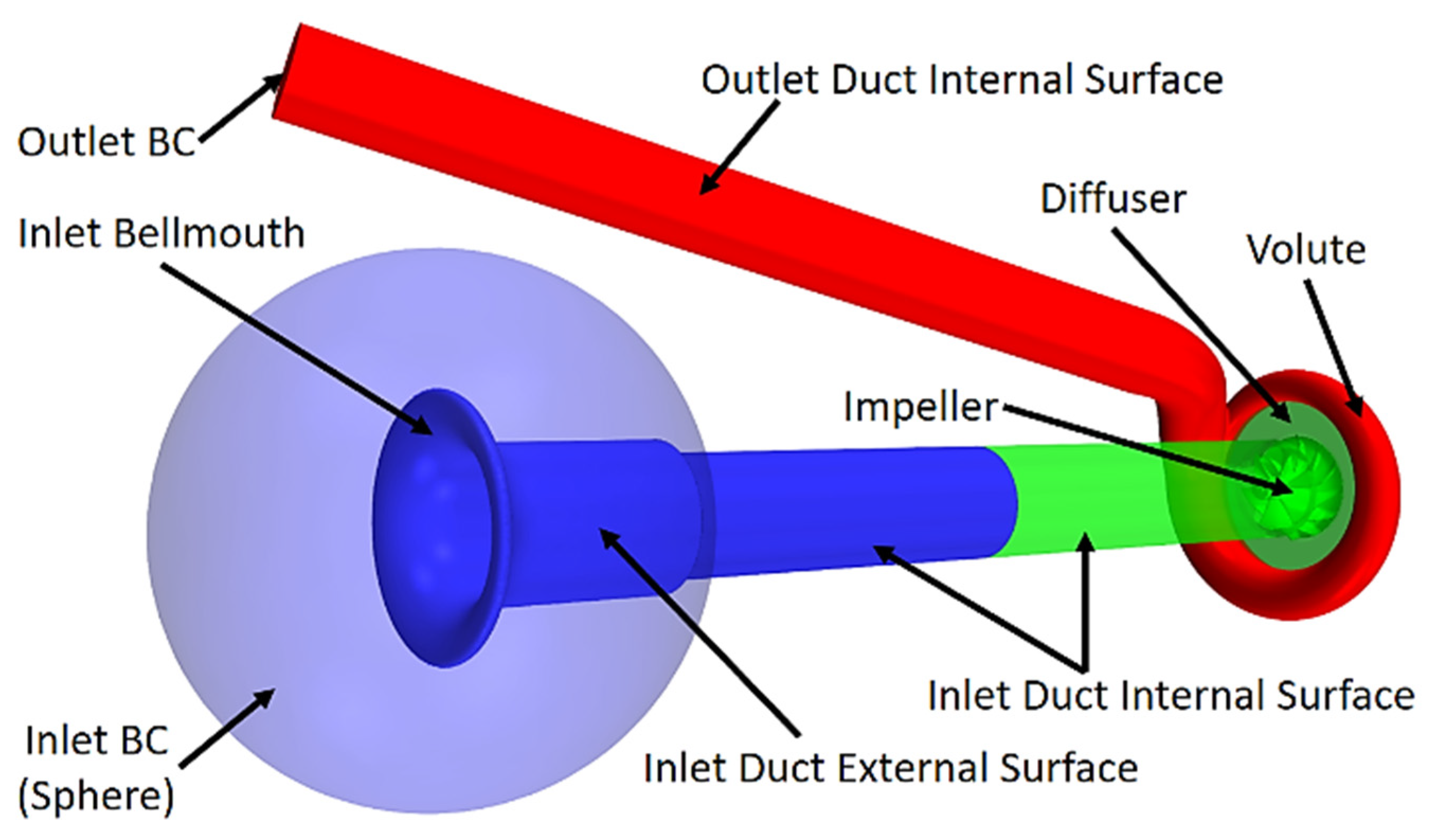
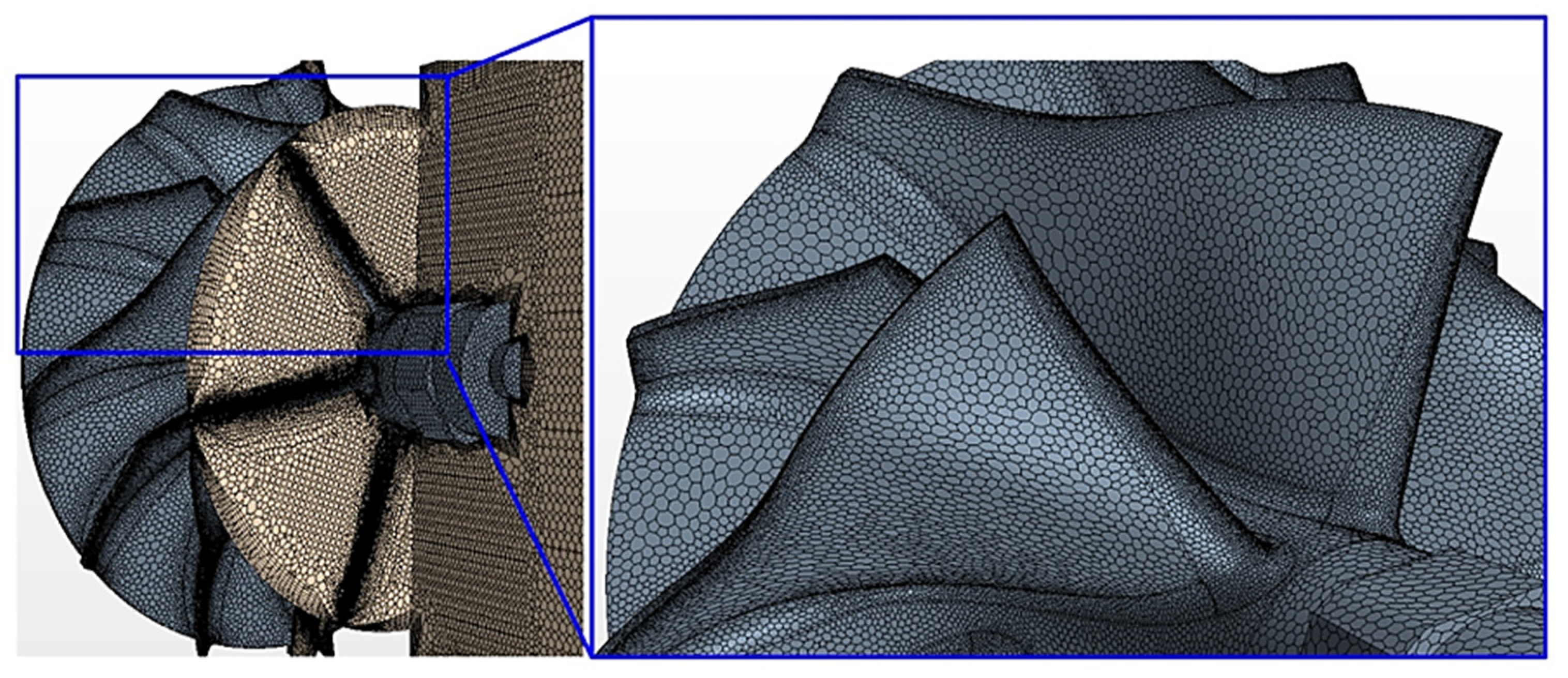
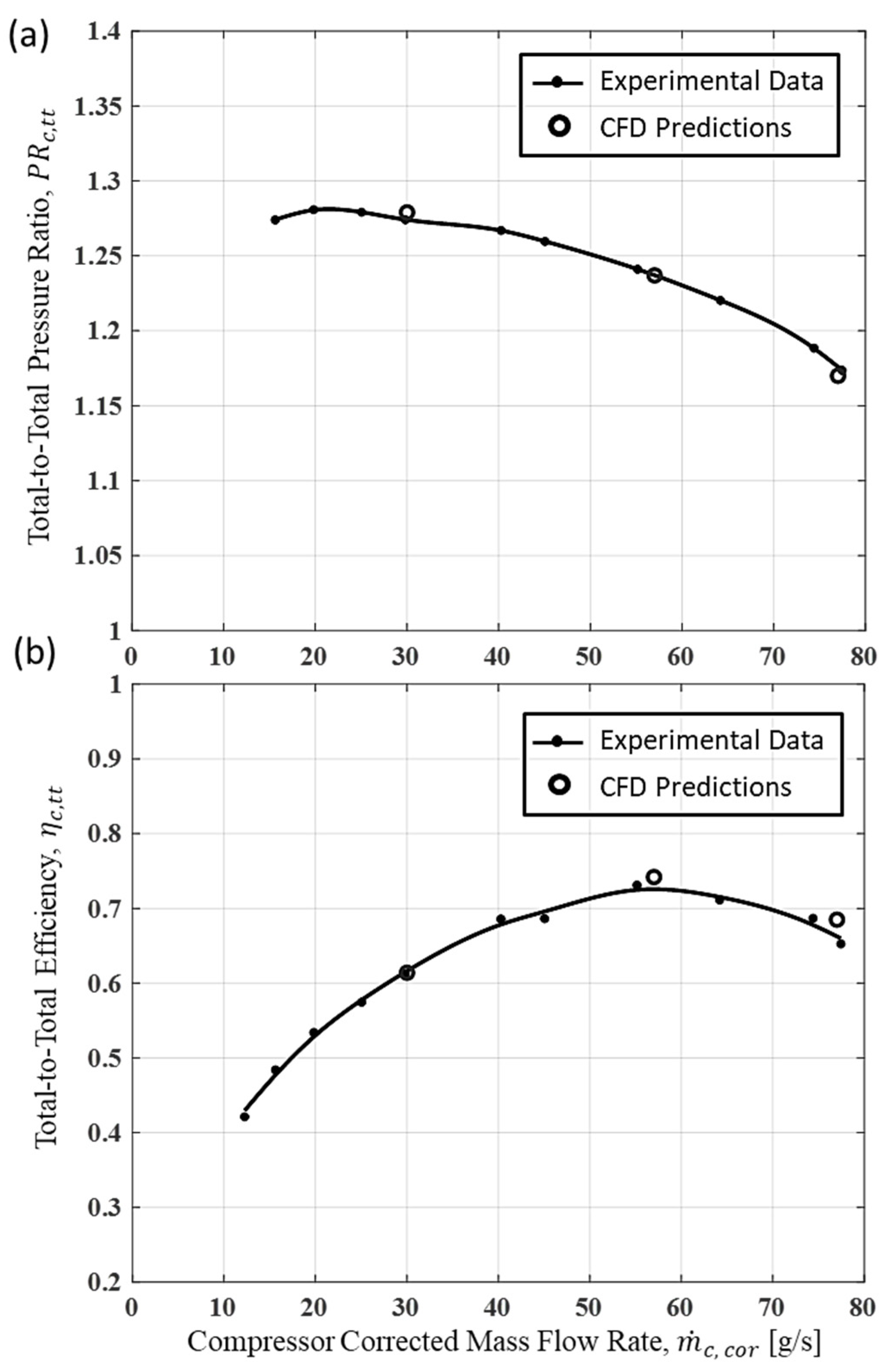

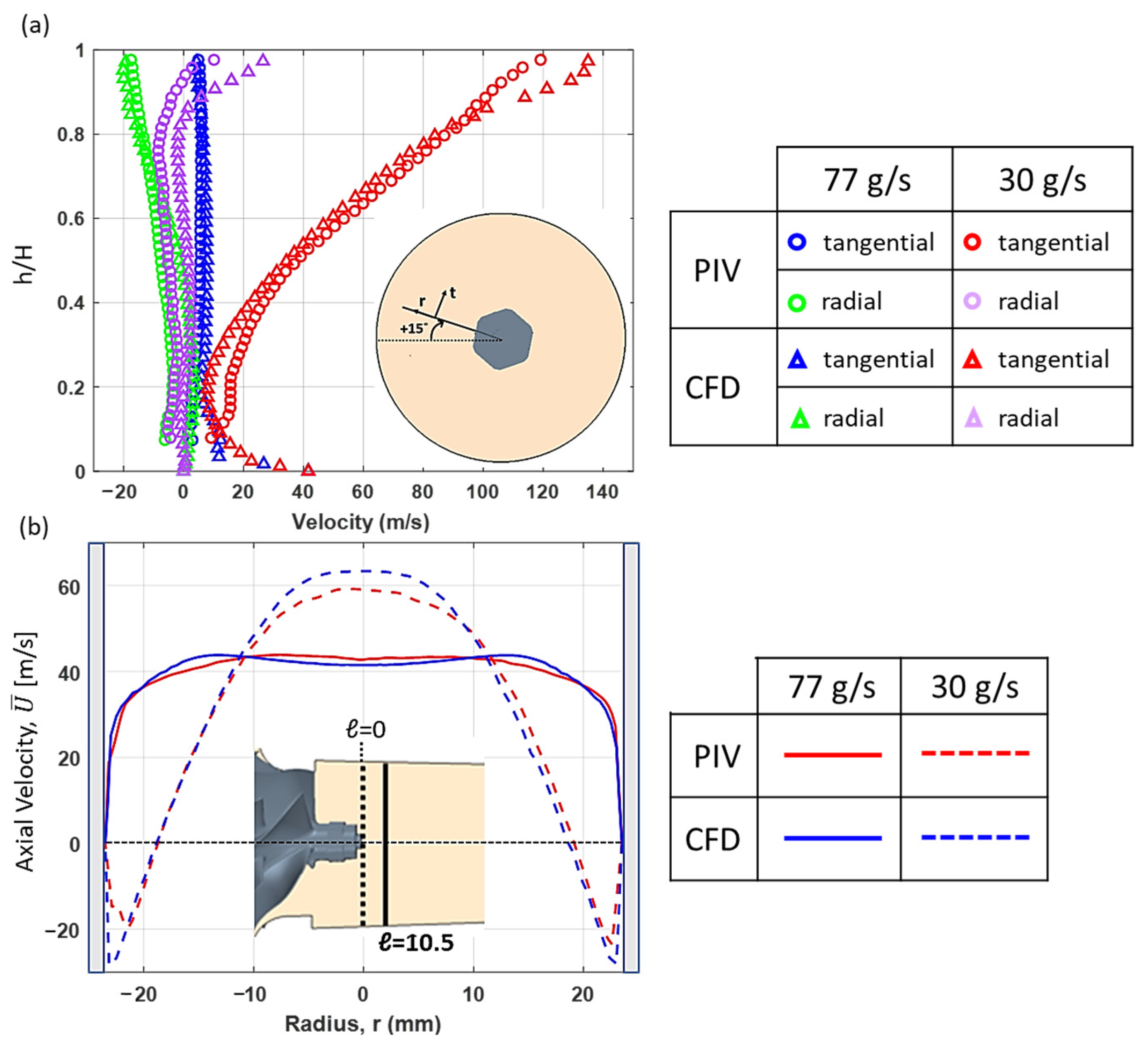
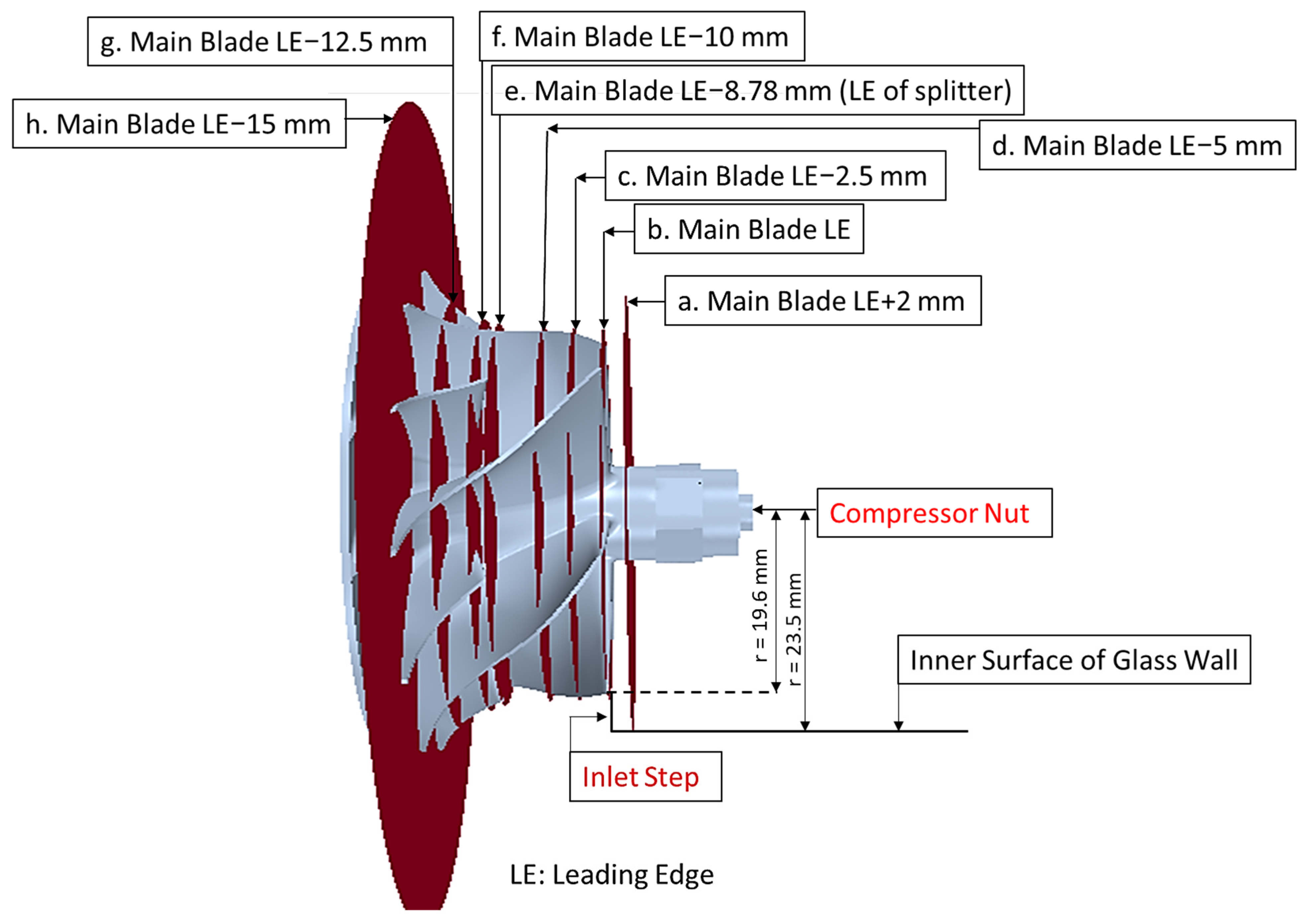
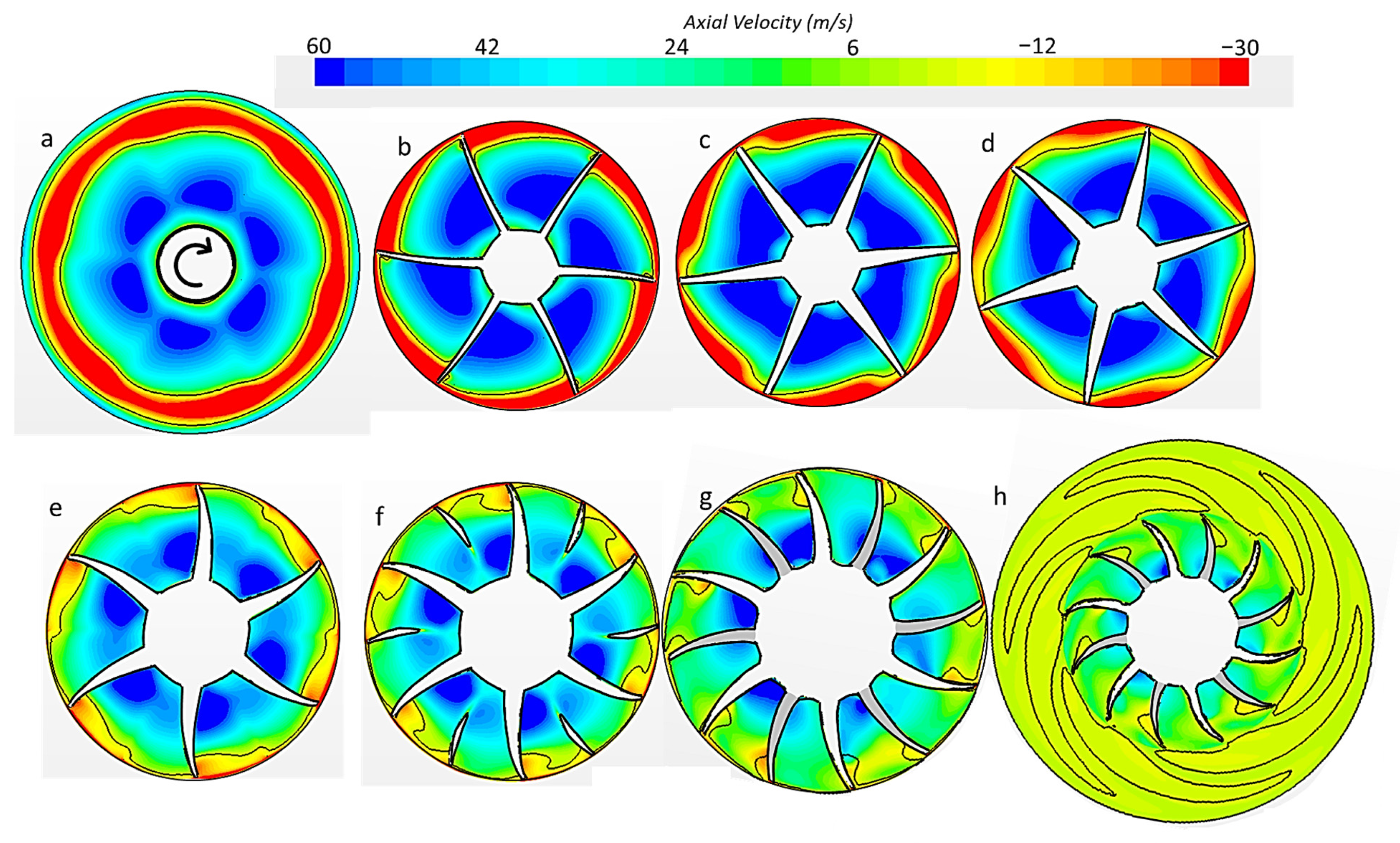

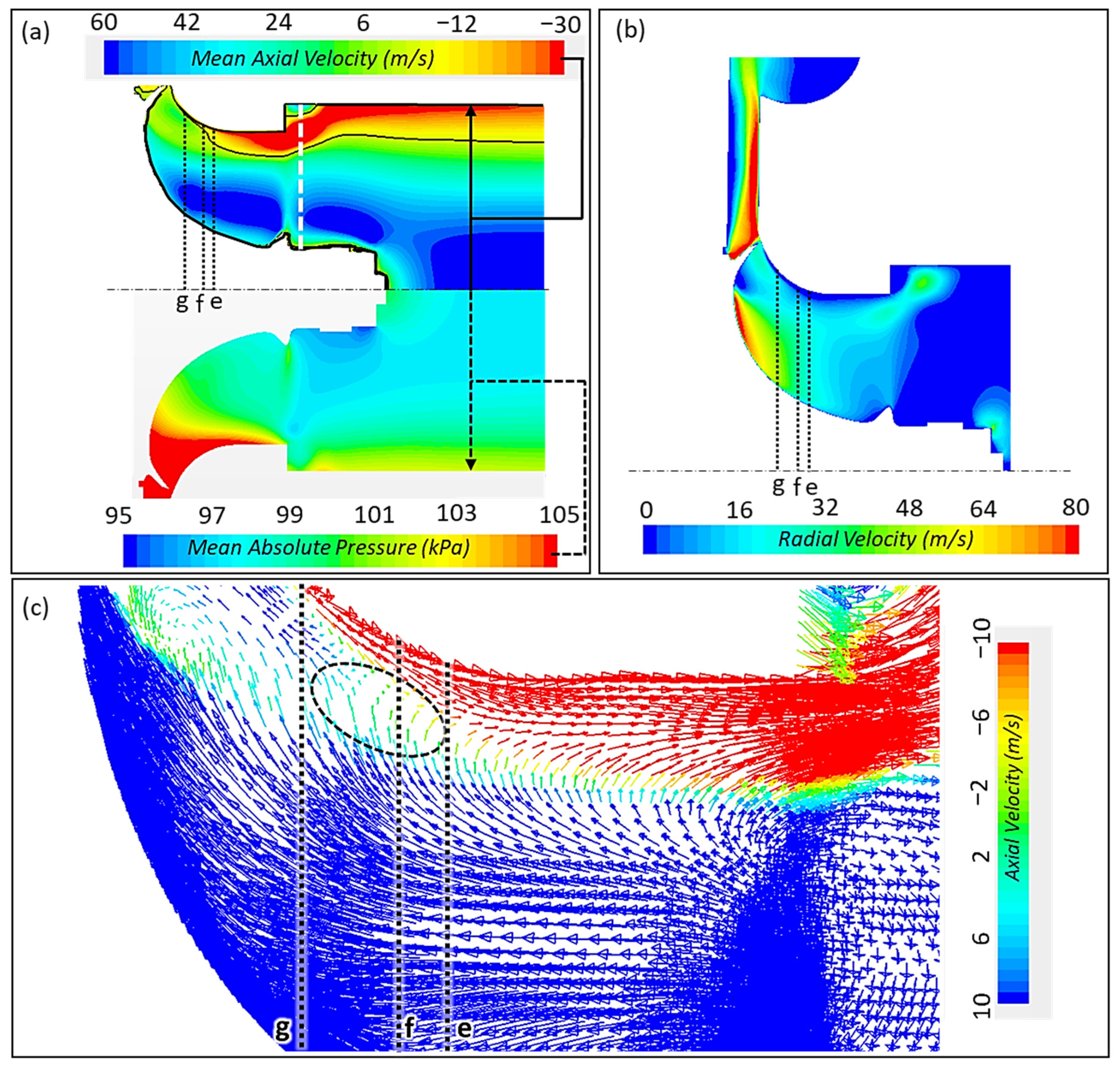
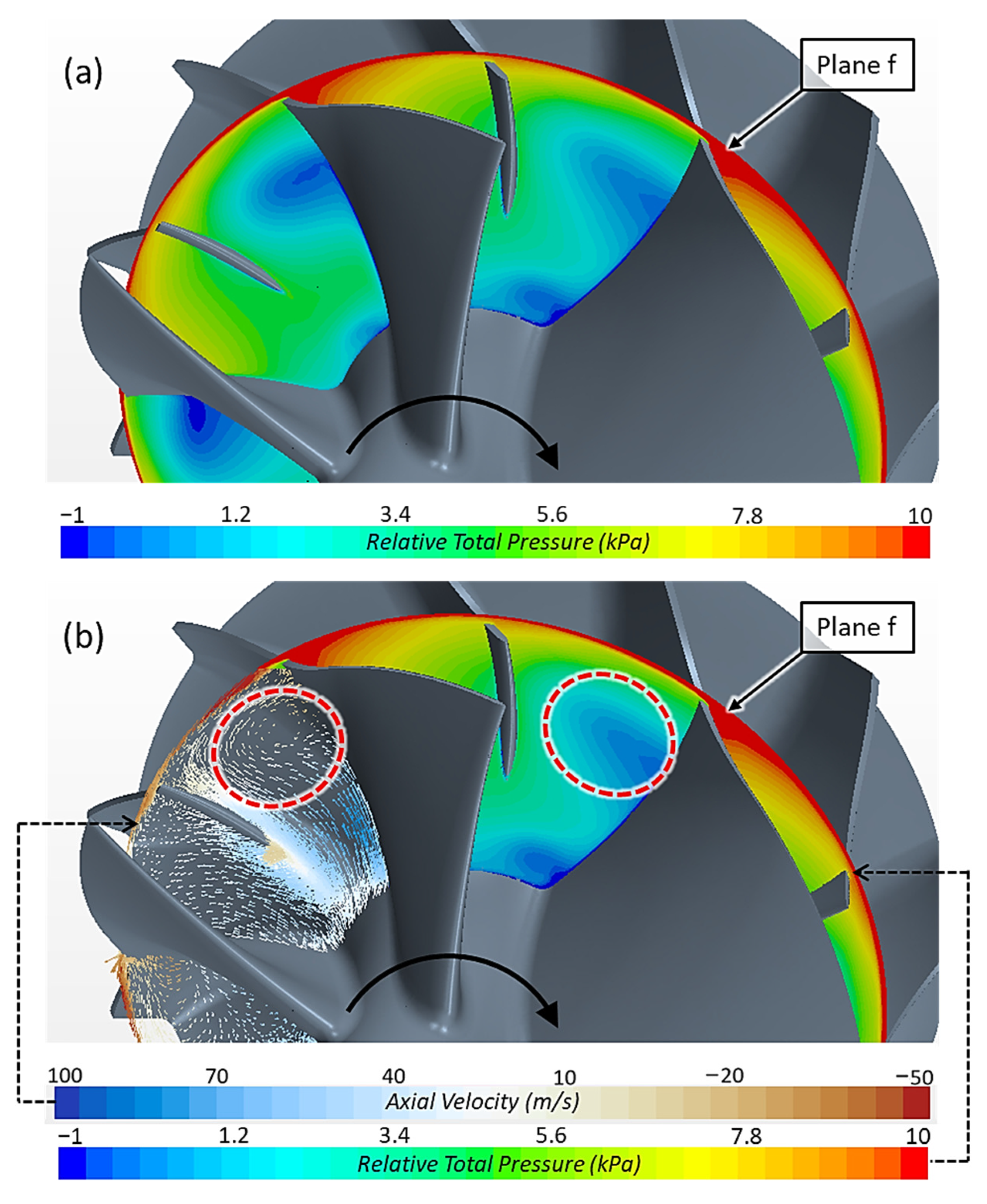
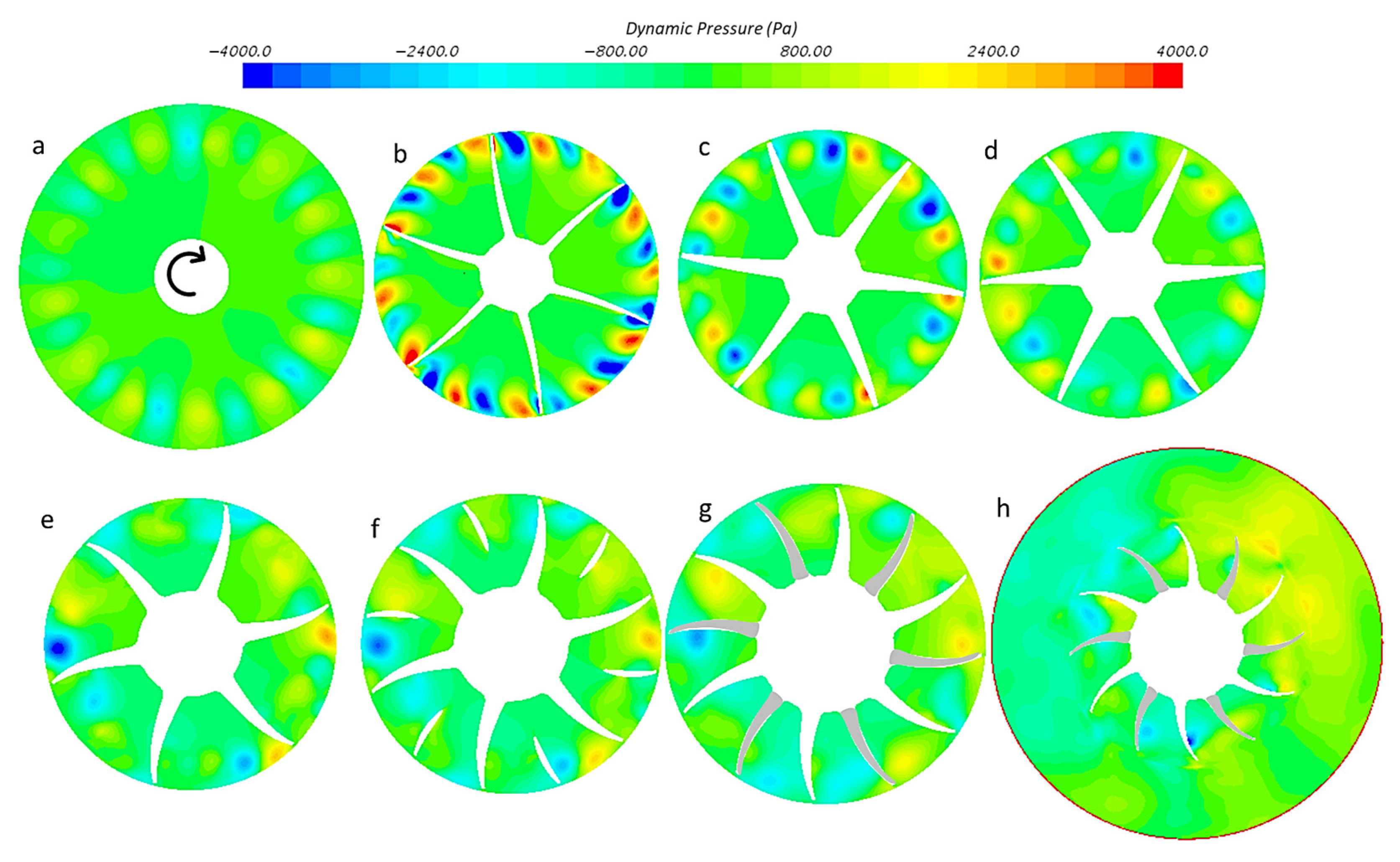
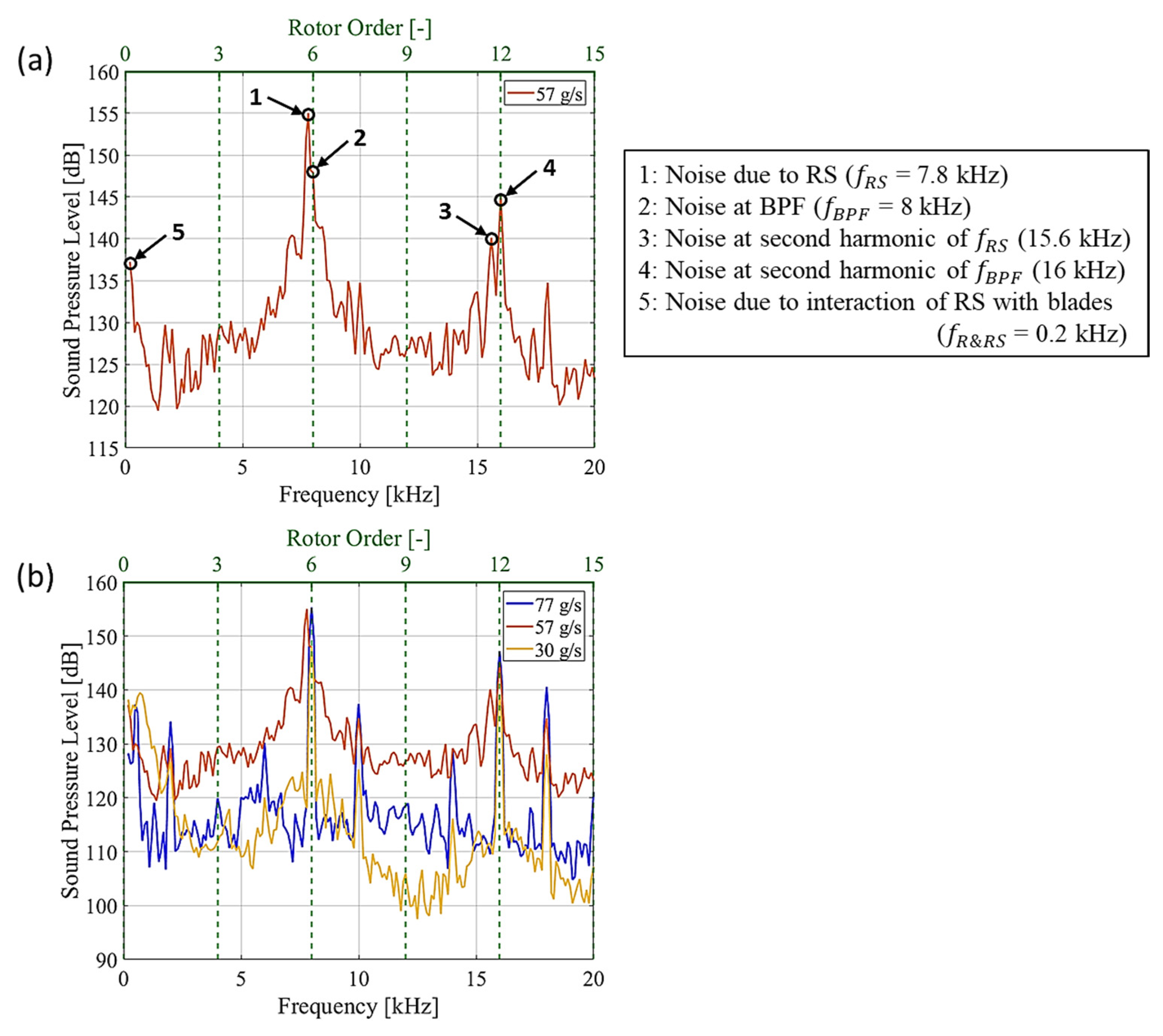
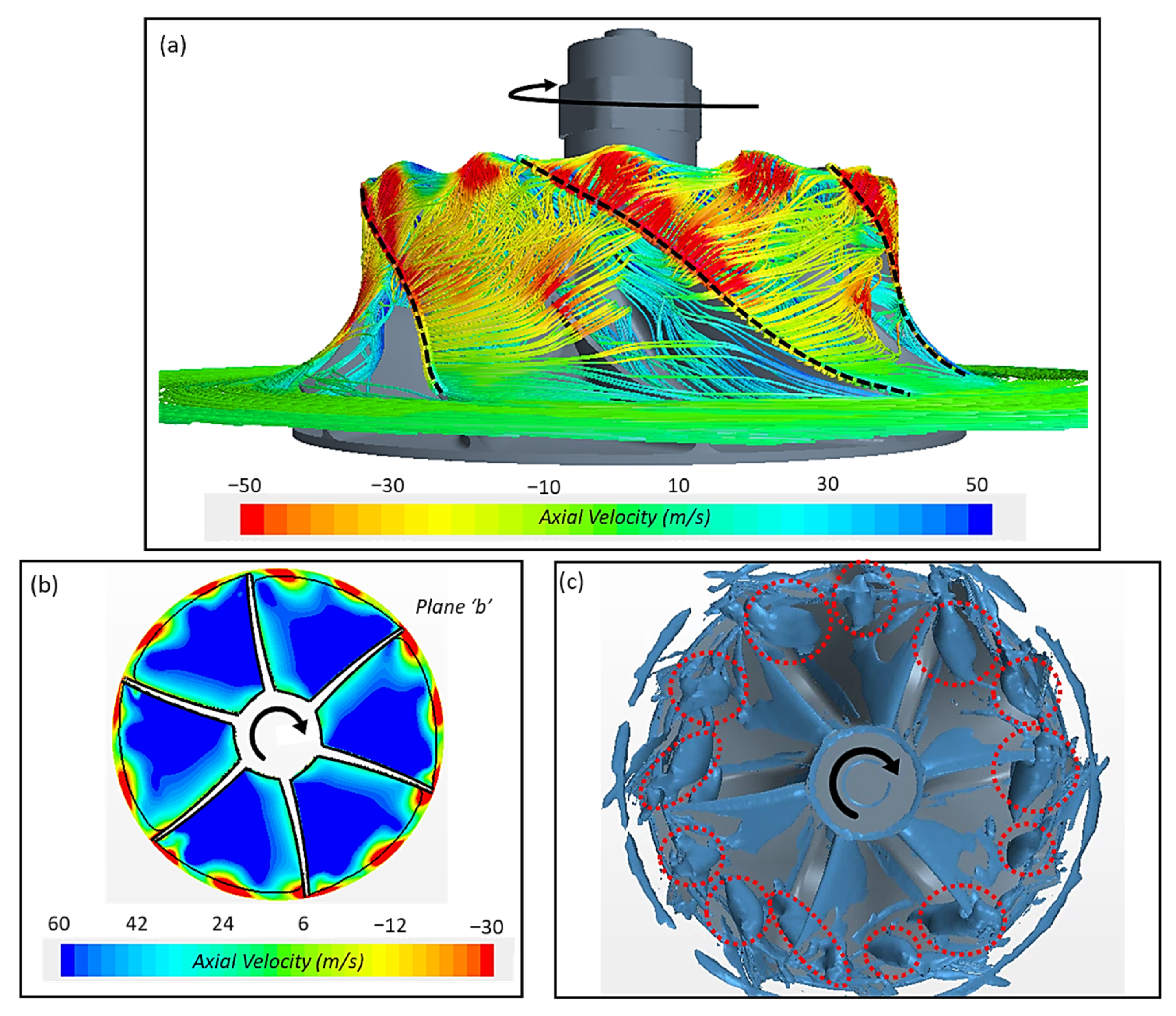
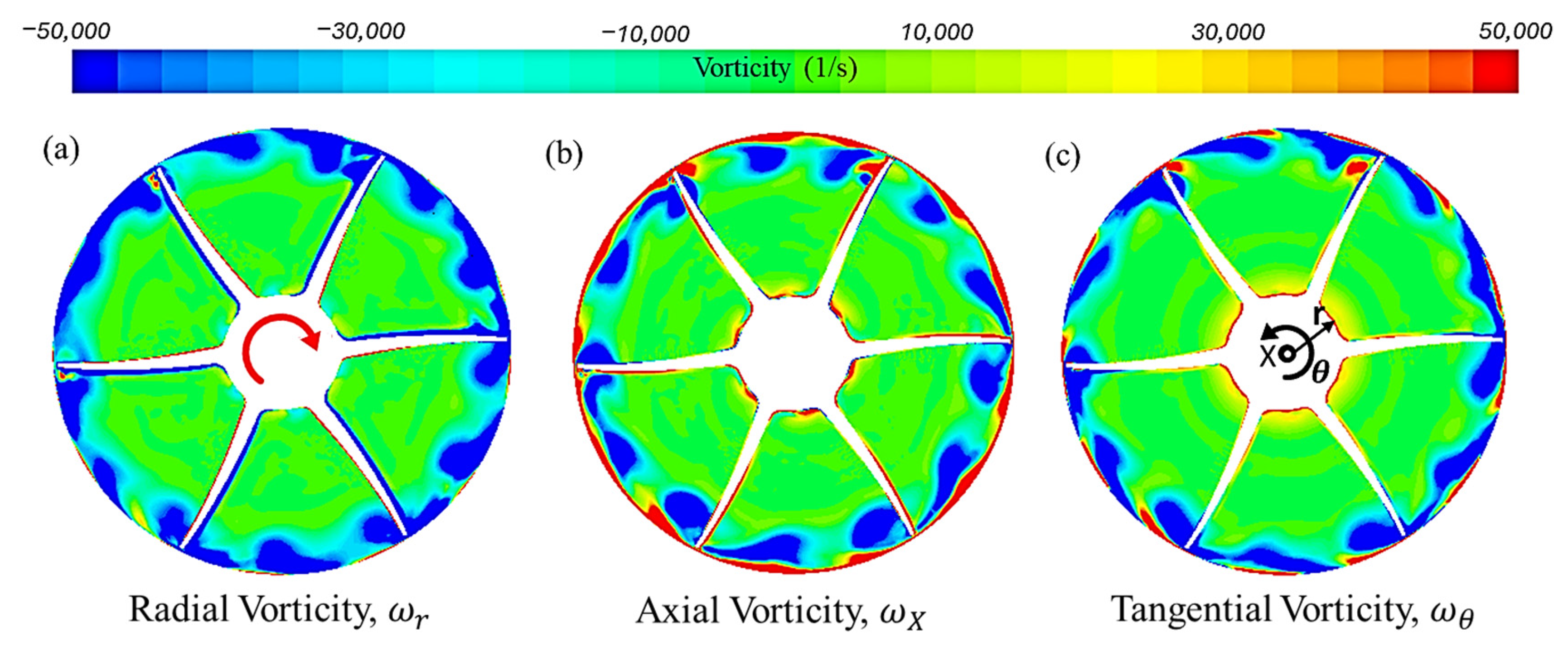
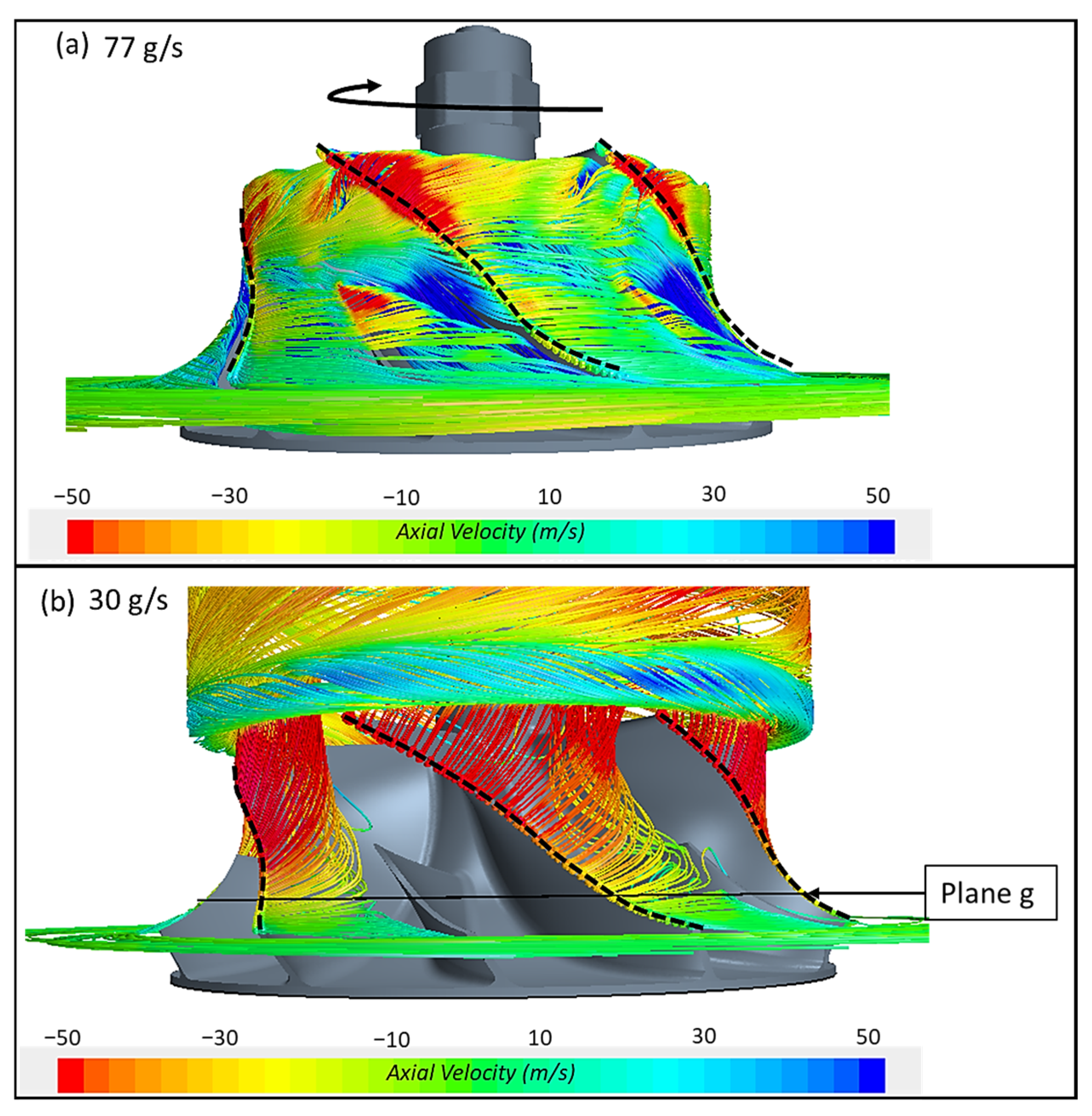
| Parameters | Value |
|---|---|
| Number of main blades | 6 |
| Number of splitter blades | 6 |
| Inducer tip radius | 19.6 mm |
| Inducer hub radius | 4.97 mm |
| Inducer shroud radius | 19.95 mm |
| Exducer diameter | 49 mm |
| Length of diffuser | 18.1 mm |
| Diffuser ‘b’ width | 3.54 mm |
| Compressor inlet duct inner radius | 23.5 mm |
| Fluid Domain | Cell Count (Million) | Boundary Conditions |
|---|---|---|
| Stationary Upstream Region | 0.38 |
|
| Rotating Region | 3.95 |
|
| Stationary Downstream Region | 0.79 |
|
| Dynamic Viscosity | 1.85508 × 10−5 Pa·s |
| Molecular Weight | 28.9664 kg/kmol |
| Specific Heat | 1003.62 J/kg·K |
| Thermal Conductivity | 0.02603 W/m·K |
| Turbulent Prandtl Number | 0.9 |
| Speed (krpm) | Mass Flow Rate (g/s) | Flow Coefficient (φ) | Reynolds Number (Re) |
|---|---|---|---|
| 80 | 77 | 0.135 | |
| 57 | 0.101 | ||
| 30 | 0.052 |
Disclaimer/Publisher’s Note: The statements, opinions and data contained in all publications are solely those of the individual author(s) and contributor(s) and not of MDPI and/or the editor(s). MDPI and/or the editor(s) disclaim responsibility for any injury to people or property resulting from any ideas, methods, instructions or products referred to in the content. |
© 2024 by the authors. Licensee MDPI, Basel, Switzerland. This article is an open access article distributed under the terms and conditions of the Creative Commons Attribution (CC BY) license (https://creativecommons.org/licenses/by/4.0/).
Share and Cite
Banerjee, D.K.; Selamet, A.; Sriganesh, P. A Computational Analysis of Turbocharger Compressor Flow Field with a Focus on Impeller Stall. Fluids 2024, 9, 162. https://doi.org/10.3390/fluids9070162
Banerjee DK, Selamet A, Sriganesh P. A Computational Analysis of Turbocharger Compressor Flow Field with a Focus on Impeller Stall. Fluids. 2024; 9(7):162. https://doi.org/10.3390/fluids9070162
Chicago/Turabian StyleBanerjee, Deb K., Ahmet Selamet, and Pranav Sriganesh. 2024. "A Computational Analysis of Turbocharger Compressor Flow Field with a Focus on Impeller Stall" Fluids 9, no. 7: 162. https://doi.org/10.3390/fluids9070162
APA StyleBanerjee, D. K., Selamet, A., & Sriganesh, P. (2024). A Computational Analysis of Turbocharger Compressor Flow Field with a Focus on Impeller Stall. Fluids, 9(7), 162. https://doi.org/10.3390/fluids9070162







